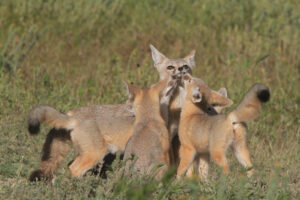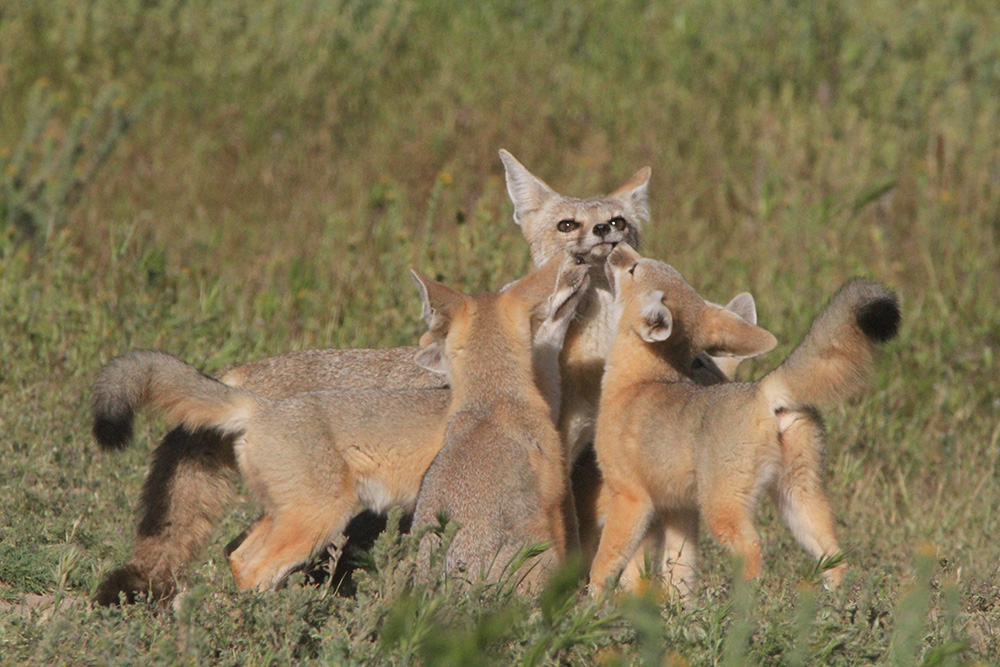FEATURES | By Chuck Graham
Foxhole Follies

Kit fox family by Chuck Graham
The ears were a dead giveaway. As the morning sun warmed the upper Cuyama River watershed, it was the large, backlit ears of a San Joaquin kit fox (Vulpes macrotis mutica) that caught my eye from the edge of the gravel bar in the dry arroyo.
Red blood vessels braiding like a red river lit up each of the fox’s ears, allowing the smallest canid on mainland North America to stay cool during the heat of the day. The slender adult, a male, was lounging on the mound of its den, watching intently as I continued down the opposite side of the river. Looking healthy and very alert, its ears are an important physical trait contributing to its survival in an arid habitat, something that continues to shrink as its home ranges succumb to advanced agricultural and urban growth.
About Those Ears
They might be considered the smallest canid on the North American mainland, with adults topping out at about five pounds, but it’s their ears that give them a distinct advantage in terms of survival. In fact, their hearing is legendary in the fox world.
Certainly, they come in handy locating prey, which lives in and around their dens. Depending on their geographical location, that may include insects, white-footed mice, antelope ground squirrels, giant kangaroo rats, desert cottontails and ground-nesting birds.
“They have the longest ears of the foxes in North America, compared to the red fox and the gray fox,” said Amrita Duggel Agee, fish and wildlife biologist with the U.S. Fish and Wildlife Service in Ventura. “Their hearing is so sensitive that they can hear a kangaroo rat moving underground in its burrow. Big ears help them hear, but serve another purpose, too. They are loaded with blood vessels that radiate body heat, aiding in regulating body temperature and helping the fox stay cool.”
They also rely on their hearing to detect the distress calls of California and antelope ground squirrels: two species that are also prey items. They react ultra-quick when one or the other chirps, the kit fox parent jumping to its feet and the pups diving into their den to avoid predation perhaps by coyotes or a golden eagle.
Den Life
The mound of the den was void of any vegetation, well-trodden, and it possessed at least six entry points. I concealed myself amongst the green ephedra and milkvetch. I was sitting quietly, motionless and low to the ground, 80 feet west of the den. For hours I hoped to capture some interaction between the pups and the pups and their parents. Kit fox litters typically range from four to seven pups.
By mid-afternoon, the more courageous pups peeked their heads out of the den.
A pair of them that eventually sunned atop the den mound. Twenty minutes later, they were back under and more waiting was required. Several more, brief sightings were reaped, but then the dad came out and so did all six pups. Dad was standing watch and the pups were at ease. For 90 minutes before sundown, rambunctious siblings greeted their parent and ran roughshod over each other.
A family of kit foxes is only as strong as its multitude of elaborate dens. Each year a successful kit fox family will have many dens for the various stages of their lives. Dens are primarily used for housing and protection, but there are dens specific to natal and pupping. “Kit foxes will often use multiple dens throughout the year, including during the pupping season,” said Abigail Gwinn, wildlife biologist for California Department of Fish and Wildlife. “This can help them to avoid flea infestations and gives them multiple possible escape routes when fleeing predators.” Kit foxes take over old dens left by ground squirrels, badgers and coyotes. They elaborate on those, constructing multiple corridors and entry points for their brood.
Shifting Gears
For six weeks I observed and photographed that specific den. One day in the early afternoon, all the pups were out with their dad, and then he left them for a different den just 75 feet to the west. All the pups looked on, but they were not ready to follow; that “pupping den” was their comfort zone.
A couple of hours late, the dad emerged, quietly walking uphill to the east on some of the smallest footpads of canids in North America. There was a sudden disturbance and then the dad emerged with a live antelope ground squirrel. He ran straight to the “pupping den” where one pup grabbed the squirrel and dove below followed by its five siblings. It was barely a minute when all the pups were above ground again, each with a portion of the squirrel. The dad once again left for the alternate den site.
“Kit foxes may expand on alternate dens,” continued Gwinn. “Sometimes they may just want a little peace and quiet away from the pups during the day, which is their usual rest period.”
Another week passed and the pups were growing up, becoming more mobile. I returned to the same den, but something had changed. I watched a California ground squirrel scamper across the top of the “pupping den.” Two hours and nothing emerged. So, I walked around, up and over a hill. Below was a saddle where I heard the familiar, low, guttural call of an adult kit fox alerting its pups to remain underground. The parent and I saw each other before it slinked beneath.
It was late May and still cool in the mornings. I had located the alternate site, sitting in silence in the bushes an hour before sunup. The first rays of sun rested directly on the den and sure enough the two, more mature pups warmed themselves on the saddle.
In the late afternoon, three of the pups were out and their dad went hunting. He vanished beyond a ridge, but it wasn’t long before he came sprinting back with another antelope ground squirrel. All three pups lunged for it but only one came away with the entire squirrel, disappearing into the den. The two other pups seemed confused, not knowing where their fresh kill had gone.
Last Bastion
Like so many other wildlife species throughout North America, habitat has been greatly fragmented. The same holds true for the San Joaquin kit fox. They once inhabited the entire San Joaquin Valley south to the upper Cuyama River and Northern Ventura and Santa Barbara Counties.
“The Carrizo Plain National Monument represents some of the largest minimally disturbed habitat for San Joaquin kit foxes and is an important refuge,” said Gwinn. “However, it is important not to rely on a single location to preserve species, especially given the potential for disease to sweep through populations. Maintaining habitat and corridors throughout their historic range is important for kit fox preservation.”


Leave A Comment